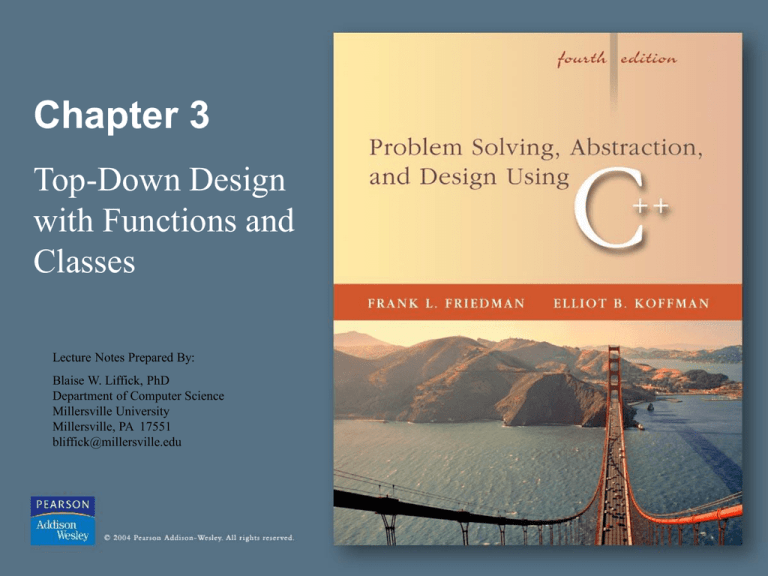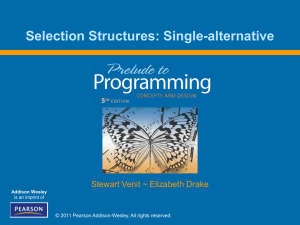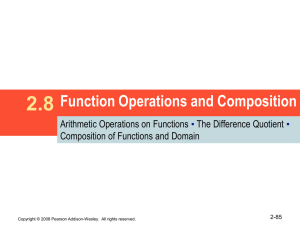
Chapter 3
Top-Down Design
with Functions and
Classes
Lecture Notes Prepared By:
Blaise W. Liffick, PhD
Department of Computer Science
Millersville University
Millersville, PA 17551
bliffick@millersville.edu
3.1 Building Programs with
Existing Information
• Analysis and design phases provide much
information to help plan and complete a
program
• Can start with data requirements to develop
constant and variable declarations
• Use the algorithm as a first step in coding
executable statements
© 2004 Pearson Addison-Wesley. All rights reserved
3-2
Case Study: Finding the Area
and Circumference of a Circle
• Problem statement
Get the radius of a circle. Compute and
display the circle’s area and circumference.
• Analysis
– input is the circle’s radius
– need calculation for the area
– need calculation for the circumference
© 2004 Pearson Addison-Wesley. All rights reserved
3-3
Case Study: Data Requirements
• Problem Constant
PI = 3.14159
• Problem input
float radius
// radius of a circle
• Problem output
float area
// area of a circle
float circum // circumference of a circle
© 2004 Pearson Addison-Wesley. All rights reserved
3-4
Case Study: Formulas
• Area of a circle = radius2
• Circumference of a circle = 2 radius
© 2004 Pearson Addison-Wesley. All rights reserved
3-5
Case Study: Design - Algorithm
1.
2.
3.
4.
Get the circle radius
Compute the area of circle
Compute the circumference of circle
Display area and circumference
© 2004 Pearson Addison-Wesley. All rights reserved
3-6
Case Study: Design - Algorithm
1. Get the circle radius
2. Compute the area of circle
2.1 Assign PI * radius * radius to area
3. Compute the circumference of circle
3.1 Assign 2 * PI * radius to circum
4. Display area and circumference
© 2004 Pearson Addison-Wesley. All rights reserved
3-7
Listing 3.2
Outline of area and circumference
program
© 2004 Pearson Addison-Wesley. All rights reserved
3-8
Listing 3.3
Finding the area and circumference of
a circle
© 2004 Pearson Addison-Wesley. All rights reserved
3-9
Listing 3.3
Finding the area and circumference of
a circle (continued)
© 2004 Pearson Addison-Wesley. All rights reserved
3-10
Case Study: Testing
• Radius of 5.0
• Should get area of 78.539…
• Should get circumference of 31.415...
© 2004 Pearson Addison-Wesley. All rights reserved
3-11
Case Study: Weight of Flat
Washers
• Problem statement
You work for a hardware company that
manufactures flat washers. To estimate
shipping costs, you company needs a
program that computes the weight of a
specified quantity of flat washers.
© 2004 Pearson Addison-Wesley. All rights reserved
3-12
Case Study: Weight of Flat
Washers
• Analysis
– flat washer is like a small donut
– need to know rim area, thickness, density
– rim area will be computed from knowing the
washer’s outer and inner diameters.
© 2004 Pearson Addison-Wesley. All rights reserved
3-13
Case Study: Data Requirements
• Problem Constant
PI = 3.14159
• Problem inputs
float holeDiameter
float edgeDiameter
float thickness
float density
float quantity
© 2004 Pearson Addison-Wesley. All rights reserved
// diameter of hole
// diameter of outer edge
// thickness of washer
// density of material used
// number of washers made
3-14
Case Study: Data Requirements
• Problem output
float weight
// weight of batch of washers
• Program Variables
float holeRadius
float edgeRadius
float rimArea
float unitWeight
© 2004 Pearson Addison-Wesley. All rights reserved
// radius of hole
// radius of outer edge
// area of rim
// weight of 1 washer
3-15
Case Study: Formulas
•
•
•
•
Area of circle = radius2
Radius of circle = diameter / 2
Rim area = area of outer circle - area of hole
Unit weight = rim area thickness density
© 2004 Pearson Addison-Wesley. All rights reserved
3-16
Listing 3.4
Washer program
© 2004 Pearson Addison-Wesley. All rights reserved
3-17
Listing 3.4
Washer program (continued)
© 2004 Pearson Addison-Wesley. All rights reserved
3-18
Case Study: Testing
Input data
inner diameter of 1.2
outer diameter of 2.4
thickness of 0.1
material density of 7.87
quantity in batch of 1000
Should produce
expected weight of batch of 2670.23 grams
© 2004 Pearson Addison-Wesley. All rights reserved
3-19
3.2 Library Functions
• Goals of software engineering
– reliable code
– accomplished by code reuse
• C++ promotes code reuse with predefined
classes and functions in the standard library
© 2004 Pearson Addison-Wesley. All rights reserved
3-20
C++ cmath Library
• Typical mathematical functions
e.g. sqrt, sin, cos, log
• Function use in an assignment statement
Function call
y = sqrt(x);
Function
name
Function
argument
© 2004 Pearson Addison-Wesley. All rights reserved
3-21
Example: sqrt Function
Function sqrt as a “black box”
X is 16.0
Square root
function
© 2004 Pearson Addison-Wesley. All rights reserved
Result is 4.0
3-22
Listing 3.5
Illustration of the use of the C++ sqrt
function
© 2004 Pearson Addison-Wesley. All rights reserved
3-23
Listing 3.5
Illustration of the use of the C++ sqrt
function (continued)
© 2004 Pearson Addison-Wesley. All rights reserved
3-24
Table 3.1
Some Mathematical Library Functions
© 2004 Pearson Addison-Wesley. All rights reserved
3-25
Table 3.1
Some Mathematical Library Functions
(continued)
© 2004 Pearson Addison-Wesley. All rights reserved
3-26
Looking Ahead
• Could write own functions
– findArea( r ) returns area of circle of radius r
– findCircum( r ) returns circumference of circle
of radius r
• Program to compute area and circumference
area = findArea(radius);
circum = findCircum(radius);
• Washers program
rimArea = findArea(edgeRadius) findArea(holeRadius);
© 2004 Pearson Addison-Wesley. All rights reserved
3-27
3.3 Top-Down Design and
Structure Charts
• Top-down design
– process to break down complex problem into
smaller, simpler subproblems
– similar to development of an algorithm
• Structure chart
– graphical representation of relationship of
subproblems
© 2004 Pearson Addison-Wesley. All rights reserved
3-28
Case Study: Simple Figures
• Problem statement
Draw some simple diagrams on the screen, e.g. a
house and a female stick figure.
• Analysis
– house is formed by displaying a triangle
without its base, on top of a rectangle
– stick figure consists of a circular shape, a
triangle, and a triangle without its base.
– 4 basic shapes: circle, base line, parallel lines,
intersecting lines
© 2004 Pearson Addison-Wesley. All rights reserved
3-29
Figure 3.4
House and stick figure
© 2004 Pearson Addison-Wesley. All rights reserved
3-30
Case Study: Design - Algorithm
• (no real data involved, so skip Data
Requirements)
• For stick figure:
1.Draw a circle.
2.Draw a triangle.
3.Draw intersecting lines.
© 2004 Pearson Addison-Wesley. All rights reserved
3-31
Case Study: Design - Algorithm
• (no real data involved, so skip Data
Requirements)
• For stick figure:
1.Draw a circle.
2.Draw a triangle.
2.1 Draw intersecting lines.
2.2 Draw a base line.
3.Draw intersecting lines.
© 2004 Pearson Addison-Wesley. All rights reserved
3-32
Case Study: Structure Chart
Original Problem
Subproblems
Detailed
subproblems
Draw a
figure
Draw a
Circle
Draw a
Triangle
Draw
intersecting
lines
© 2004 Pearson Addison-Wesley. All rights reserved
Level 0
Draw
intersecting
lines
Draw a
base
Level 1
Level 2
3-33
3.4 Functions without Arguments
•
•
•
•
•
Functions important part of top-down design
main( ) is a function called by the OS
Form of call: fname( );
Example:
drawCircle( );
Interpretation: the function fname is
activated. After fname finishes execution,
the program statement that follows the
function call will be executed next.
© 2004 Pearson Addison-Wesley. All rights reserved
3-34
Some Notes on Functions
• Don’t need to know details about how a
function is implemented to know how to call.
• E.g.
y = sqrt(x);
// don’t know how sqrt implemented
• Do know how function is used (called).
• Empty parentheses indicate no arguments
(more on this later).
© 2004 Pearson Addison-Wesley. All rights reserved
3-35
Function Prototype
• Declares the function to the compiler
• Appears before function main.
• Tells compiler the function’s type, its name,
and information about arguments.
© 2004 Pearson Addison-Wesley. All rights reserved
3-36
Function Prototype (no Arguments)
• Form:
ftype fname( );
• Example:
void skipThree( );
• Interpretation: identifier fname is declared
to be the name of a function. The identifier
ftype specifies the data type of the function
result. Ftype of void indicates the function
does not return a value.
© 2004 Pearson Addison-Wesley. All rights reserved
3-37
Function Definitions
• Specifies the function’s operations
• Function header similar to function prototype
• Function body contains declarations for local
variables and constants and executable
statements
• Prototypes precede main function (after
#include directives)
• Function definitions follow main function
© 2004 Pearson Addison-Wesley. All rights reserved
3-38
Function Definition (no arguments)
• Syntax: ftype fname( )
{
local declarations
executable statements
}
© 2004 Pearson Addison-Wesley. All rights reserved
3-39
Function Definition (no arguments)
• Example:
// Displays block-letter H
void printH( )
{
cout << “** **” << endl;
cout << “** **” << endl;
cout << “******” << endl;
cout << “******” << endl;
cout << “** **” << endl;
cout << “** **” << endl;
}
// end printH
© 2004 Pearson Addison-Wesley. All rights reserved
3-40
Order of Execution
int main( )
{
drawCircle( );
drawTriangle( );
drawIntersect( );
return 0;
}
© 2004 Pearson Addison-Wesley. All rights reserved
void drawCircle( )
{
cout << “ * “ << endl;
cout << “ * * “ << endl;
cout << “ * * “ << endl;
//return to calling function
} // end drawCircle
3-41
Notes on Function Execution
• Execution always begins at first statement
of main function
• When a function is called
–
–
–
–
space is set aside for function variables
statements of function are executed
control returns to statement following call
function ends with space released
© 2004 Pearson Addison-Wesley. All rights reserved
3-42
Function Advantages
•
•
•
•
•
•
•
Team assignments on large project
Simplify tasks
Each function is a separate unit
Top-down approach
Reuse (e.g. drawTriangle)
Procedural abstraction
Information hiding
© 2004 Pearson Addison-Wesley. All rights reserved
3-43
Displaying User Instructions
• Simple functions (no arguments, no return
value) are of limited use
• Useful for displaying instructions to user
• E.g.
void instruct( );
// prototype
…
instruct( );
//function call
© 2004 Pearson Addison-Wesley. All rights reserved
3-44
Figure 3.10
Function instruct
// Displays instructions to user of area/circumference program
void instruct ()
{
cout << "This program computes the area and " << endl;
cout << "circumference of a circle. " << endl << endl;
cout << "To use this program, enter the radius of the "
<< endl;
cout << "circle after the prompt" << endl;
cout << "Enter the circle radius: " << endl << endl;
cout << "The circumference will be computed in the same”
<< endl;
cout << "units of measurement as the radius. The area "
<< endl;
cout << "will be computed in the same units squared."
<< endl << endl;
}
© 2004 Pearson Addison-Wesley. All rights reserved
3-45
Functions with Input Arguments
• Functions used like building blocks
• Build systems one function at a time
– E.g. stereo components
• Use function arguments to carry
information into function subprogram
(input arguments) or to return multiple
results (output arguments)
© 2004 Pearson Addison-Wesley. All rights reserved
3-46
Functions with Input Arguments
• Arguments make functions versatile
• E.g.:
rimArea = findArea(edgeRadius) findArea(holeRadius);
© 2004 Pearson Addison-Wesley. All rights reserved
3-47
void Functions with Input
Arguments
• Give data to function to use
• Don’t expect function to return any result(s)
• Call format:
fname (actual-argument-list);
• E.g.:
drawCircleChar(‘*’);
© 2004 Pearson Addison-Wesley. All rights reserved
3-48
drawCircleChar(‘*’);
symbol
void drawCircle(char symbol)
‘*’
{
cout << “
“ << symbol << endl;
cout << “ “ << symbol << “
cout << “
“ << symbol << endl;
“ << symbol << “ “ << symbol << endl;
} // end drawCircle
© 2004 Pearson Addison-Wesley. All rights reserved
3-49
Functions with Arguments and a
Single Result
• Functions that return a result must have a
return statement:
Form:
return expression;
Example: return x * y;
© 2004 Pearson Addison-Wesley. All rights reserved
3-50
#include <iostream>
#include <cmath>
using namespace std;
const float PI = 3.14159;
float findCircum(float);
float findArea(float);
int main( )
{
float radius = 10.0;
float circum;
float area;
circum = findCircum(radius);
area = findArea(radius);
cout << “Area is “ << area << endl;
cout << “Circumference is “ << circum << endl;
return 0;
}
© 2004 Pearson Addison-Wesley. All rights reserved
3-51
Figure 3.12
Functions findCircum and
findArea
// Computes the circumference of a circle with radius r
// Pre: r is defined and is > 0.
//
PI is a constant.
// Post: returns circumference
float findCircum(float r)
{
return (2.0 * PI * r);
}
// Computes the area of a circle with radius r
// Pre: r is defined and is > 0.
//
PI is a constant.
// Post: returns area
float findArea(float r)
{
return (PI * pow(r,2));
}
© 2004 Pearson Addison-Wesley. All rights reserved
3-52
circum = findCircum(radius);
circum
call findCircum
radius
10
62.8318
r
62.8318
float findCircum(float r)
{
return (2.0 * PI * r);
}
© 2004 Pearson Addison-Wesley. All rights reserved
10
3-53
Function Definition (Input
Arguments with One Result)
• Syntax:
// function interface comment
ftype fname(formal-parameter-declaration-list)
{
local variable declarations
executable statements
}
© 2004 Pearson Addison-Wesley. All rights reserved
3-54
Function Definition (Input
Arguments with One Result)
• Example:
// Finds the cube of its argument.
// Pre: n is defined.
int cube(int n)
{
return (n * n * n);
}
© 2004 Pearson Addison-Wesley. All rights reserved
3-55
Function Prototype
(With Parameters)
• Form:
ftype fname(formal-parameter-type-list);
• Example:
int cube(int);
© 2004 Pearson Addison-Wesley. All rights reserved
3-56
Function Interface Comments
• Preconditions
– conditions that should be true before function is
called
– // Pre: r is defined
• Postconditions
– conditions that will be true when function
completes execution
– // Post: Returns circumference
© 2004 Pearson Addison-Wesley. All rights reserved
3-57
Problem Inputs vs. Input
Parameters
• Problem inputs
– variables that receive data from program user
– through execution of input statement
• Input parameters
– receive data through execution of function call
statement
– must be defined before function is called
© 2004 Pearson Addison-Wesley. All rights reserved
3-58
Listing 3.14:
Testing function testScale.cpp
// File testScale.cpp
// Tests function scale.
#include <iostream>
#include <cmath>
using namespace std;
// Function prototype
float scale(float, int);
© 2004 Pearson Addison-Wesley. All rights reserved
3-59
Listing 3.14:
Testing function testScale.cpp
(continued)
int main()
{
float num1;
int num2;
// Get values for num1 and num2
cout << "Enter a real number: ";
cin >> num1;
cout << "Enter an integer: ";
cin >> num2;
// Call scale and display result.
cout << "Result of call to function scale is "
<< scale(num1, num2)
<< endl;
return 0;
}
© 2004 Pearson Addison-Wesley. All rights reserved
3-60
Listing 3.14:
Testing function testScale.cpp
(continued)
// Multiplies its first argument by the power of 10
// specified by its second argument.
// Pre: x and n are defined and library cmath is
//
included
float scale(float x, int n)
{
float scaleFactor;
// local variable
scaleFactor = pow(10, n);
return (x * scaleFactor);
}
© 2004 Pearson Addison-Wesley. All rights reserved
3-61
Listing 3.14:
Testing function testScale.cpp
(continued)
cout << "Result of call to function
scale is "
<< scale(num1, num2) Actual arguments
.
<< endl;
.
.
Information flow
float scale(float x, int n)
Formal parameters
{
float scaleFactor;
// local
variable
scaleFactor = pow(10, n);
return (x * scaleFactor);
}
© 2004 Pearson Addison-Wesley. All rights reserved
3-62
Argument/Parameter List
Correspondence
• Must have same number of actual
arguments and formal parameters
• Order of arguments in the lists determines
correspondence
• Each actual argument must be of a data type
that is compatible to the corresponding
formal parameter
• The names of the actual arguments do not
need to correspond to the formal parameters
© 2004 Pearson Addison-Wesley. All rights reserved
3-63
Function Data Area
• Each time function is executed
– an area of memory is allocated for storage of
the function’s data (formal parameters and local
variables)
– it is created empty with each call to the function
• When the function terminates
– the data area is lost
© 2004 Pearson Addison-Wesley. All rights reserved
3-64
Data Areas After Call
scale(num1, num2);
Function
main Data
Area
num1
Function
Scale Data
Area
x
2.5
2.5
num2
n
-2
-2
scaleFac
tor
?
© 2004 Pearson Addison-Wesley. All rights reserved
3-65
Testing Functions Using Drivers
• Any function can be tested independently
• Test driver
– defines values for the function’s arguments
– calls the function
– displays the value returned for verification
© 2004 Pearson Addison-Wesley. All rights reserved
3-66
Scope of Names
• Scope - where a particular meaning of a
name is visible or can be referenced
• Local - can be referred to only within the
one function
– applies to
• formal argument names
• constants and variables declared within the function
• Global - can be referred to within all
functions
– useful for constants
– must be used with care
© 2004 Pearson Addison-Wesley. All rights reserved
3-67
Listing 3.15
Outline of program for studying
scope of names
© 2004 Pearson Addison-Wesley. All rights reserved
3-68
Using Class string
• Data abstraction
– facilitated in C++ through class feature
– enables programmers to define new types
– defines a set a values and a set of operations
© 2004 Pearson Addison-Wesley. All rights reserved
3-69
Accessing the String Library
• Must include the appropriate library
#include <string>
© 2004 Pearson Addison-Wesley. All rights reserved
3-70
String Objects
• Attributes include
– character sequence it stores
– length
• Common operations
<< >>
=
+
© 2004 Pearson Addison-Wesley. All rights reserved
3-71
Listing 3.16
Illustrating string operations
© 2004 Pearson Addison-Wesley. All rights reserved
3-72
Listing 3.16
Illustrating string operations (continued)
© 2004 Pearson Addison-Wesley. All rights reserved
3-73
Declaring string Objects
• General declarations format:
type identifier1, identifier2, . . .;
• E.g.:
string firstName, lastName;
string wholeName;
string greeting = “Hello “;
© 2004 Pearson Addison-Wesley. All rights reserved
3-74
Reading and Displaying Strings
• Extraction operator is defined for strings
cin >> firstName;
// reads up to blank or return
• Insertion operator is defined for strings
cout << greetings << wholeName << ‘!’ << endl;
• Can read string with blanks
getline(cin, lastName, ;\n’);
© 2004 Pearson Addison-Wesley. All rights reserved
3-75
String Assignment and
Concatenation
• + puts strings together (concatenates)
• E.g.:
wholeName = firstName + “ “ + lastName;
• Note need for space between names
© 2004 Pearson Addison-Wesley. All rights reserved
3-76
Operator Overloading
• Note use of +
– usually means addition for two numeric values
– has been redefined (overloaded) to also mean
concatenation when applied to two strings
• Useful when defining new types
© 2004 Pearson Addison-Wesley. All rights reserved
3-77
Accessing String Operations
• Member functions length and at
• These functions can be called using dot
notation
• Applies the identified operation to the
named object
• E.g.:
wholeName.length( )
returns the length of the string currently
stored in the variable wholeName
© 2004 Pearson Addison-Wesley. All rights reserved
3-78
Dot Notation
• Syntax:
• Ex:
object.function-call
firstName.at(0)
this returns the character in firstName that is
at position 0 (start numbering characters
from left, beginning at 0).
© 2004 Pearson Addison-Wesley. All rights reserved
3-79
Additional Member Functions
• Searching for a string
wholeName.find(firstName)
• Inserting characters into a string
wholeName.insert(0, “Ms.”);
• Deleting portion of a string
wholeName.erase(10,4);
• Assign a substring to a string object
title.assign(wholeName, 0 3);
© 2004 Pearson Addison-Wesley. All rights reserved
3-80








